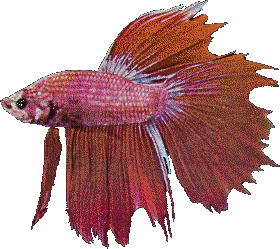Prepare the food cultures:
Getting Bettas to spawn is the easy
part:
raising the fry is more difficult. Consequently, it is best to
begin
any breeding program by developing a rich culture of micro-organisms
such
as "infusoria" and rotifers and a culture of micro-worms and brine
shrimp.
"Infusoria" is
a term that is used to refer to micro-organisms such as Euglena
and
Paramecium that grow rapidly when pond water is infused
with
rotting leaves, such as lettuce or hay straw. Fill a small
container with pond water or water siphoned from the bottom of an
established
aquarium and add a handful of soft lettuce leaves and/or hay straw to
it
and let it stand for several days. Adding green water from a pond
or tank will help the culture develop. As the leaves rot,
micro-organisms
develop in the water in large numbers, feeding on the decomposing
leaves.
These can be seen with a low powered microscope- a micro-zoo in a tub!
Use a turkey-baster or large eye-dropper to remove
the culture
to feed to the tiny Betta fry in the first days that they are seen free
swimming.
Micro-worms
are tiny
worms that are easily cultured in a mix of "Easy Oats" or rolled oats
mixed
with boiled water to a thick, creamy consistency to which a little
bakers
yeast is added for fermentation.
Prepare the fish for spawning by
feeding them well with live foods such as brine shrimp, black worms,
blood
worms and mosquito larvae. Frozen foods are acceptable for this,
too.
When ready to breed, females will be
plump and
show an egg spot at the vent and males will built a bubble nest at the
water surface. The nests may be any size but are usually 5-6 cms
across, with the bubbles piled high. Water temperature increases
may trigger nest building and water temperature is an important factor,
males that show no interest in breeding a water temperature 25oC
will do so when the temperature rises to 27-28oC.
Adjust the water temperature to
the optimum range for breeding, 28oC (82oF),
and ensure that the cover plate is in place so that a humid, warm air
space
exist above the water surface. Betta breeding is also possible
within
the range 26oC - 30oC (80-86oF) and
some
breeders have good results at temperatures around 84oF.
Place the male Betta in a wide topped
container
that is at least 15 cms deep and fitted with a close fitting
cover.
The water should be well aged and clean and provided with floating
plants
(Duckweed is suitable) or half of a polystyrene cup cut length
wise.
If he is ready to breed he will build a bubble nest at the top of the
water
among the plants or beneath the cup. When he has finished
building
his nest he will swim just below it and guard it fiercely.
Prepare the fish
Feed both the males and females a balanced diet, including live-foods,
to condition then prior to mating. Select males that have begun to
build their bubble nests (or wait until the selected specimen does so).
Getting Bettas to spawn presents
few problems. Select a "ripe" female Betta, one showing a swollen
belly full of eggs, and displaying the brooding stripes that female
Bettas
develop when ready to breed. If she is ready to lay eggs, a small
white spot may be seen at her vent (ovipositor). Place her in
with
the male.
The male Betta will begin to display and
to chase
the female and tend to his bubble nest with more intensity.
Fights
may occur if neither fish is ready to spawn. The whole process
can
appear very violent.
Sometimes a female will release her eggs
prematurely
if the male excites her. If this happens then the eggs will
not be fertilized so you will have to begin over again with a new
female-
or wait until the first one is ready again.
|
